ACC 2018, Day Three: Gout, Hypertension, Diabetes, PFO Closure, DAPT, NOAC Reversal, and More
Monday’s two late breakers swung from clinical cardiology to ACS and interventions, new drugs and devices, and tried and trusted therapies.
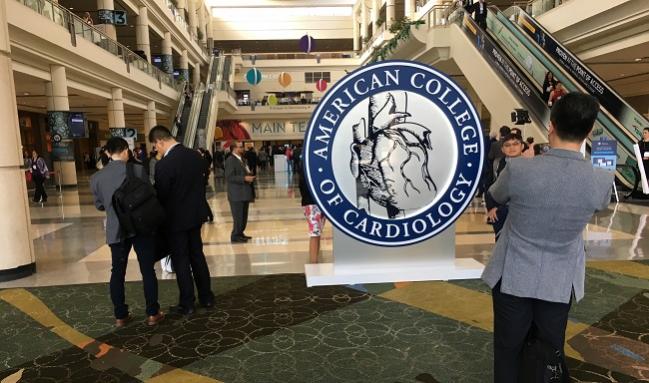
12:30 PM - Next Up: Interventional Late Breakers
Disappointing news to patients with critical limb ischemia (CLI) from the AD trial: the experimental drug JVS-100 has failed to enhance wound healing, at least at 3-month follow-up. The biologic therapy, paired here with revascularization, was meant to improve blood flow by encouraging the growth of smaller vessels near the skin’s surface, where wounds develop.
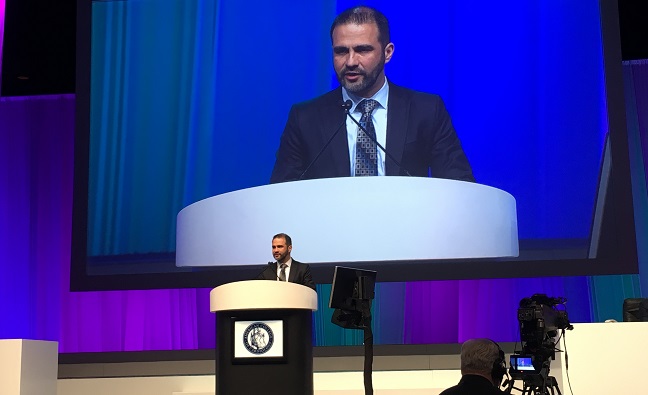 But in the STOP-PAD study, which enrolled 109 patients at 21 US centers, just one-quarter saw their wounds completely heal by 3 months after intervention, regardless of whether they’d been given JVS-100 or placebo. During that time frame, the major adverse limb event rate (major amputation, bypass, or balloon revascularization in the affected limb) was 14% with treatment and 9% with placebo. Patients are being tracked for 12 months.
But in the STOP-PAD study, which enrolled 109 patients at 21 US centers, just one-quarter saw their wounds completely heal by 3 months after intervention, regardless of whether they’d been given JVS-100 or placebo. During that time frame, the major adverse limb event rate (major amputation, bypass, or balloon revascularization in the affected limb) was 14% with treatment and 9% with placebo. Patients are being tracked for 12 months.
Help for these patients represents an urgent unmet need, as panelists observed following the presentation by lead author Mehdi Shishehbor, DO, PhD, MPH (University Hospitals of Cleveland, OH). “We will anxiously await 6-month results,” he said. “However, future biologic data may require addressing multiple pathways.”

The trial enrolled 120 survivors of cryptogenic stroke at two centers in South Korea. All patients had a high-risk PFO, defined as either a PFO of at least 2 millimeters in diameter or an atrial septal aneurysm or hypermobility. In patients that met these criteria, those treated with PFO closure had no primary outcome events over 2 years. By contrast, the rate of event-free survival (no stroke, vascular death, or TIMI major bleeding) was 87.1% in the medication-only arm (log-rank P valve = 0.013).
Stay tuned for full details.
Next up was SMART-DATE, looking at 2,712 patients with ACS amenable to PCI and comparing 12-month DAPT to 6 months, with a primary endpoint of MACCE at 18 months after implantation of everolimus-, zotarolimus-, or biolimus-eluting stents. Six-month DAPT met the prespecified criteria for noninferiority as compared with 12-month DAPT for the primary composite endpoint. In secondary findings, however, MI was more common in the 6-month versus the 12-month DAPT group, Hyeon Cheol Gwon, MD (Samsung Medical Center, Seoul, South Korea), showed here. “The increase MI risk with 6-month DATP prevents us from concluding that short-term DAPT is safe in patients undergoing PCI,” he concluded.
“It’s very interesting that you actually met your primary endpoint, but are advising against 6-month DAPT,” session moderator Roxana Mehran, MD (Icahn School of Medicine at Mount Sinai, New York, NY), commented.
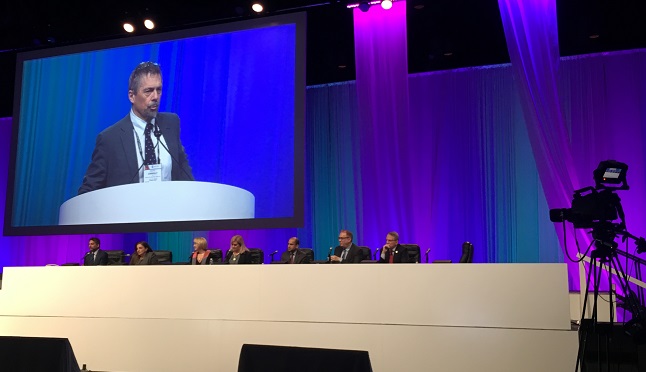
As Stuart Connolly, MD (McMaster University, Hamilton, Canada), showed in another interim analysis here, median anti-factor Xa inhibitor activity—one of two primary endpoints—was reduced by 88% in patients taking rivaroxaban, 91% percent for patients taking apixaban, and 75% for patients taking enoxaparin. For the second co-primary endpoint, clinical hemostasis, was achieved in 83% of patients overall.
#ACC18
— Amit V. Khera (@amitvkhera) March 12, 2018
SJ Connolly ANNEXA-4:
Promising results for FXa (riva, apix, enox) reversal in bleeding patients w/ Xa decoy.
~90% reversal at 2hrs. pic.twitter.com/84MTB8lncv
Full story coming soon.
* * * * *
9:00 AM - It’s a busy morning for the TCTMD team at the American College of Cardiology 2018 Scientific Session. Here’s some top-line results from the late breakers. Check back for full details on these studies throughout the day and in the days to come.
 In the CARES trial, investigators led by William White, MD (University of Connecticut School of Medicine, Farmington), found that febuxostat, a drug approved for the treatment of gout nearly a decade ago, significantly increases the risk of all-cause death compared with allopurinol, although the risk of the trial’s composite primary endpoint—fatal and nonfatal cardiovascular events—was no higher. ““This finding was entirely unexpected, and we’re at a loss at this time to explain why this finding was seen,” White commented in a press release.
In the CARES trial, investigators led by William White, MD (University of Connecticut School of Medicine, Farmington), found that febuxostat, a drug approved for the treatment of gout nearly a decade ago, significantly increases the risk of all-cause death compared with allopurinol, although the risk of the trial’s composite primary endpoint—fatal and nonfatal cardiovascular events—was no higher. ““This finding was entirely unexpected, and we’re at a loss at this time to explain why this finding was seen,” White commented in a press release.
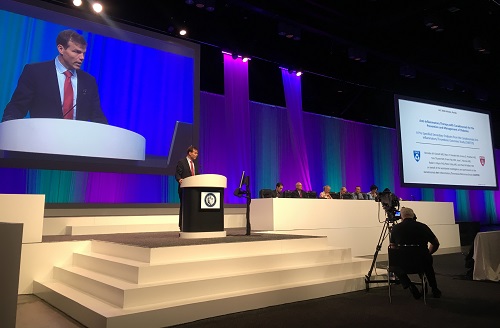 Investigators for one of the most talked about trials of 2017 have taken a closer look at new diabetes in CANTOS. The hope was that the anti-inflammatory canakinumab, which significantly reduced the risk of MACE in post-MI patients with elevated high-sensitivity C-reactive protein, might also have an impact on diabetes, also believed to involve inflammatory pathogenesis. Alas, as Brendan Everett, MD (Brigham and Women’s Hospital, Boston, MA), showed here, while canakinumab appeared to help lower hbA1c, this did not prevent subjects with prediabetes from progressing to diabetes.
Investigators for one of the most talked about trials of 2017 have taken a closer look at new diabetes in CANTOS. The hope was that the anti-inflammatory canakinumab, which significantly reduced the risk of MACE in post-MI patients with elevated high-sensitivity C-reactive protein, might also have an impact on diabetes, also believed to involve inflammatory pathogenesis. Alas, as Brendan Everett, MD (Brigham and Women’s Hospital, Boston, MA), showed here, while canakinumab appeared to help lower hbA1c, this did not prevent subjects with prediabetes from progressing to diabetes.
On a happier note, canakinumab appeared to be equally effective at preventing CV events in patients with type 2 diabetes who are at high risk for cardiovascular complications, Everett noted.
#CANTOS: Baseline hsCRP and IL6 levels predict incident #diabetes, and canakinumab reduced levels of these inflammatory biomarkers. But canakinumab did not reduce risk of incident diabetes. #ACC18 pic.twitter.com/R8PnCo4srV
— Erin D. Michos, M.D. (@ErinMichos) March 12, 2018
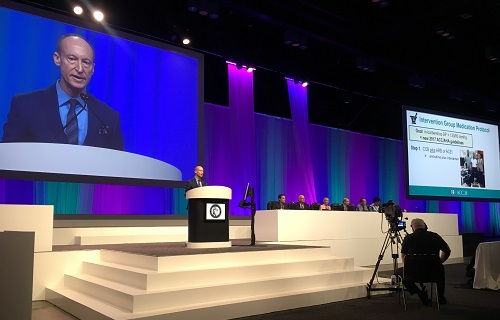 Black barbershops have already been established as a unique locale for blood pressure interventions. In new research presented here by Ronald G. Victor, MD (Smidt Heart Institute at Cedars-Sinai, Los Angeles, CA), reported that drug therapy, when provided by specialty-trained pharmacists in the barbershops, led to better blood pressure lowering than did standard therapy offered in primary care practices.
Black barbershops have already been established as a unique locale for blood pressure interventions. In new research presented here by Ronald G. Victor, MD (Smidt Heart Institute at Cedars-Sinai, Los Angeles, CA), reported that drug therapy, when provided by specialty-trained pharmacists in the barbershops, led to better blood pressure lowering than did standard therapy offered in primary care practices.
“Black men have many CVD risk factors,” Victor observed. “Marked BP reductions—if sustained and initiated widely—may reduce high hypertension-related disability and death among black men in the United States.”
In a poignant moment, Victor dedicated the study presentation to his co-author Anthony Reid, MD, who passed away as the study was wrapping up.
Fantastic example of taking the treatment to the patient. Major impact on BP in black US men, having primary care in trusted community members (barbershops) where 'patients' frequent. Really worth reading and thoughts on what we could consider in the UKproactive health promotion pic.twitter.com/RbGsBEA7pb
— tony gershlick (@tony_ger) March 12, 2018
 Sticking with blood pressure, there’s more evidence that low-dose triple therapy, combined in a single pill, is associated with better BP lowering than standard care. According to Ruth Webster, MBBS (The George Institute for Global Health at the University of New South Wales in Sydney, Australia), who presented the TRIUMPH trial here, Sri Lankan patients randomized to the combo pill (telmisartan 20 mg, amlodipine 2.5 mg, and chlorthalidone 12.5 mg) achieved a mean change in systolic BP from baseline of -29.1 mm Hg as compared with -20.3 mm Hg in the control group (P < 0.001). Mean change in diastolic BP for each group was -13.9 and -9.3, respectively (P < 0.001). Side effects warranting a therapy change were equivalent between groups. Low- and middle-income countries have the most “urgent need” for swift implementation and scale-up, Webster concluded, adding that high-income countries, including the United States where compliance is an important issue, could also benefit from such an approach.
Sticking with blood pressure, there’s more evidence that low-dose triple therapy, combined in a single pill, is associated with better BP lowering than standard care. According to Ruth Webster, MBBS (The George Institute for Global Health at the University of New South Wales in Sydney, Australia), who presented the TRIUMPH trial here, Sri Lankan patients randomized to the combo pill (telmisartan 20 mg, amlodipine 2.5 mg, and chlorthalidone 12.5 mg) achieved a mean change in systolic BP from baseline of -29.1 mm Hg as compared with -20.3 mm Hg in the control group (P < 0.001). Mean change in diastolic BP for each group was -13.9 and -9.3, respectively (P < 0.001). Side effects warranting a therapy change were equivalent between groups. Low- and middle-income countries have the most “urgent need” for swift implementation and scale-up, Webster concluded, adding that high-income countries, including the United States where compliance is an important issue, could also benefit from such an approach.
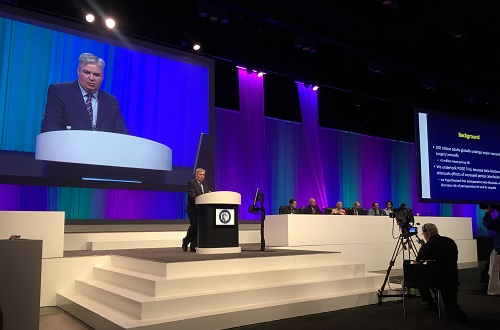 In the final trial of the 8 AM late-breaking session, PJ Devereaux, MD, PhD (Population Health Research Institute, Hamilton, Canada, presented 1-year results from POISE. Yes, this is the much-delayed follow-up from 30-day results first unveiled in 2008 showing that perioperative beta-blockers in patients undergoing noncardiac surgery appeared to reduce the risk of MI, but also to up the risk of stroke or death. As Devereaux showed here, however, the longer-term outcomes are also worth notice. At 1 year, patients randomized to the metoprolol group remained significantly more likely to experience stroke or death than patients originally randomized to placebo.
In the final trial of the 8 AM late-breaking session, PJ Devereaux, MD, PhD (Population Health Research Institute, Hamilton, Canada, presented 1-year results from POISE. Yes, this is the much-delayed follow-up from 30-day results first unveiled in 2008 showing that perioperative beta-blockers in patients undergoing noncardiac surgery appeared to reduce the risk of MI, but also to up the risk of stroke or death. As Devereaux showed here, however, the longer-term outcomes are also worth notice. At 1 year, patients randomized to the metoprolol group remained significantly more likely to experience stroke or death than patients originally randomized to placebo.
Poise-2 long term results: Beneficial effects of CR metoprolol in pts undergoing non cardiac surgery offset by hivher mortality and stroke. Incomplete data due to problems in Canada (Would they have changed results? I don't think so. @rladeiraslopes pic.twitter.com/xuHLSJecfc
— Sergio Kaiser (@pabeda1) March 12, 2018
Shelley Wood was the Editor-in-Chief of TCTMD and the Editorial Director at the Cardiovascular Research Foundation (CRF) from October 2015…
Read Full Bio

Comments